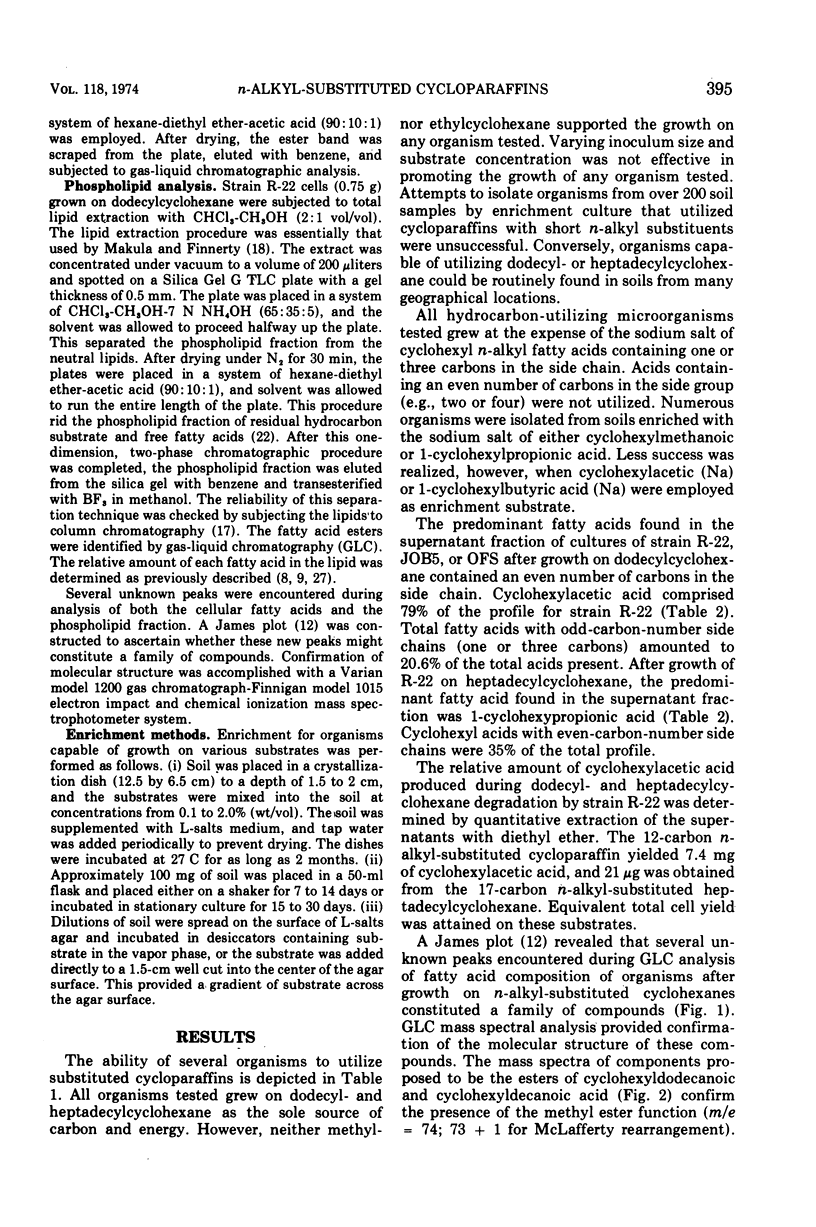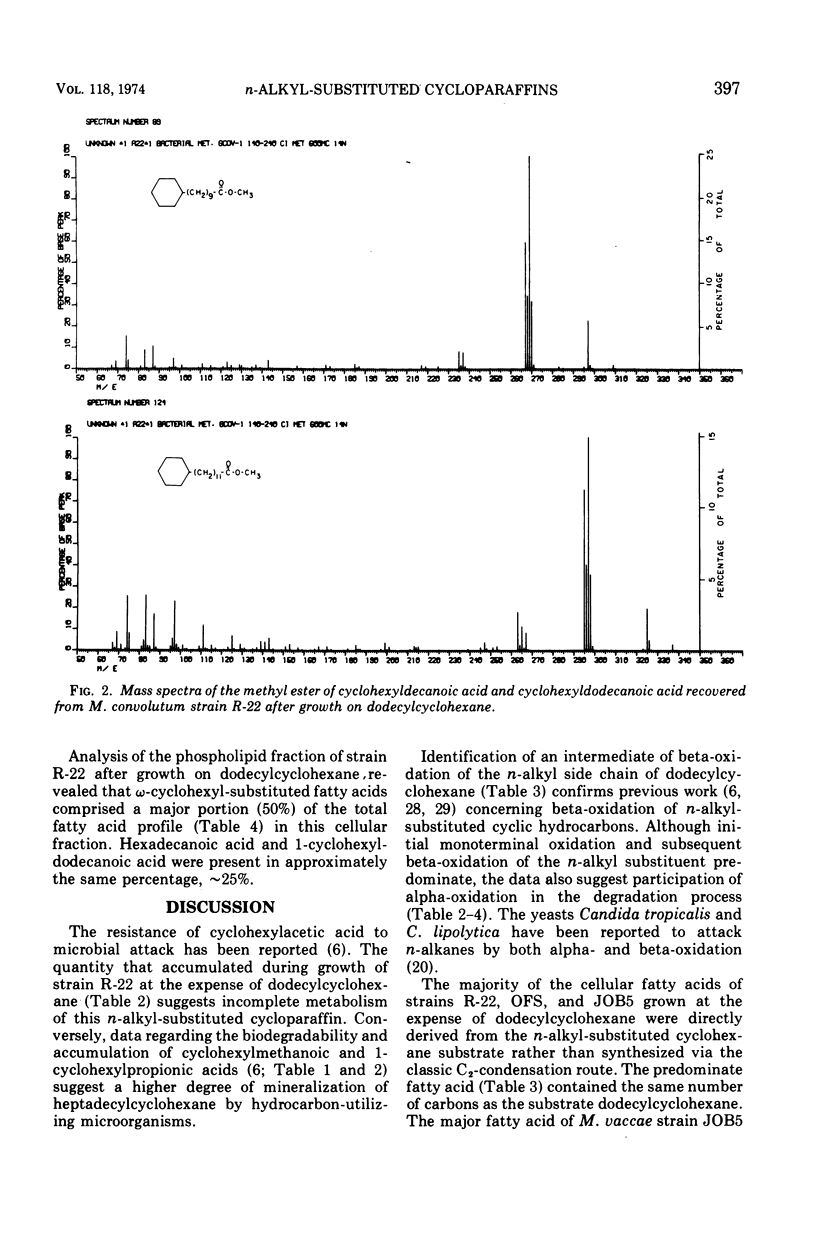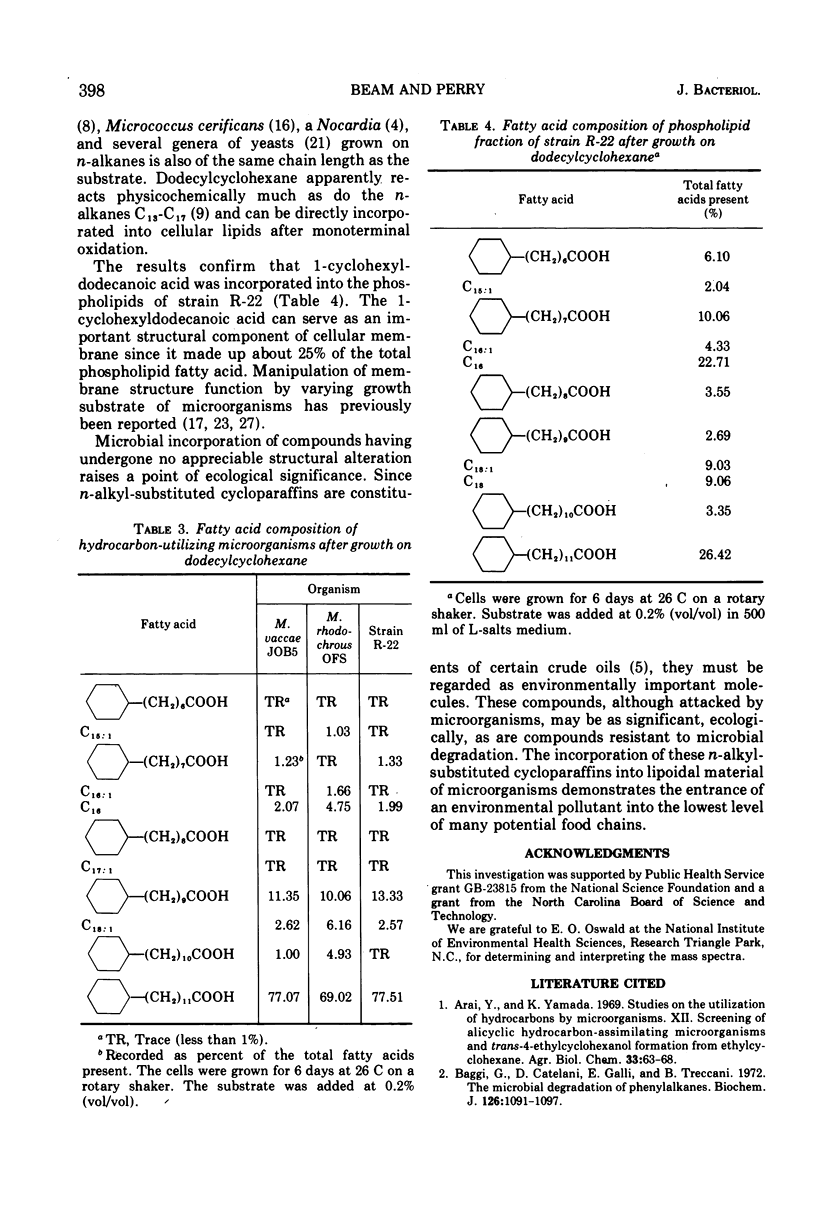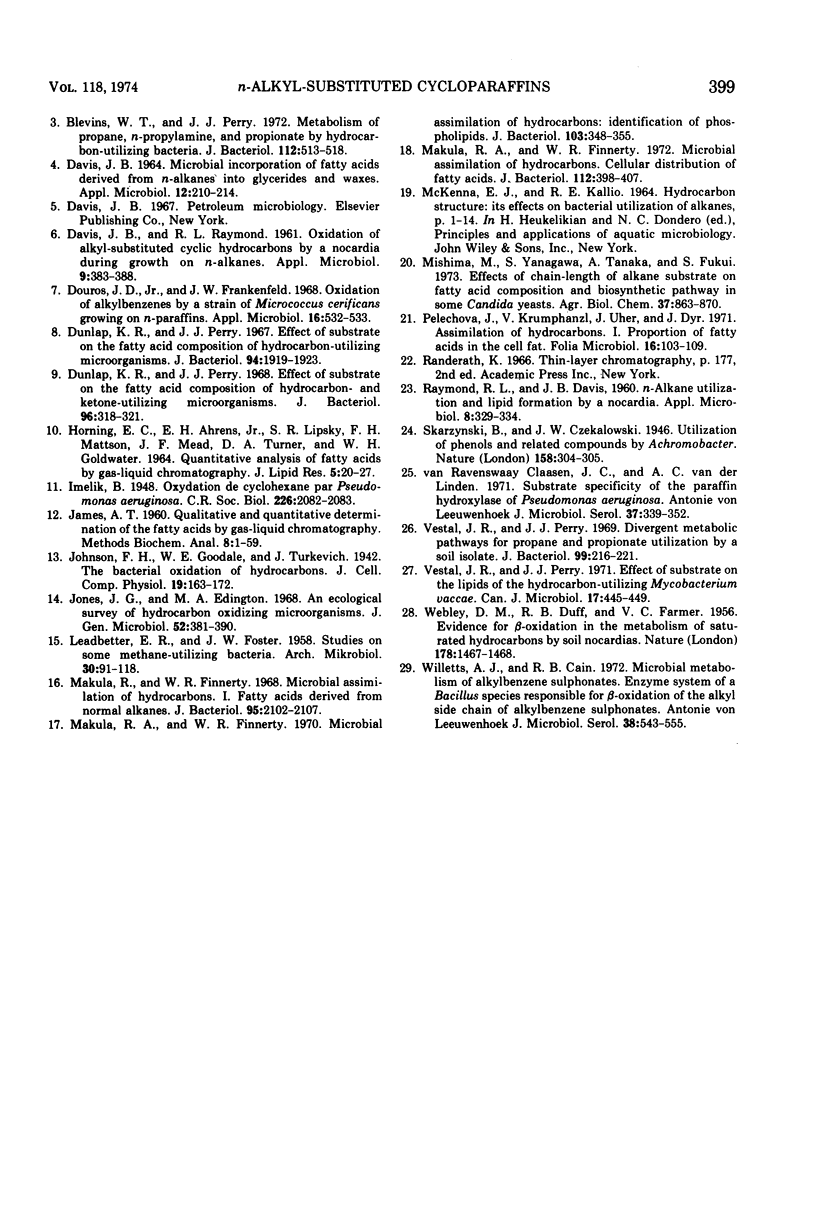Abstract
Studies were conducted on the oxidation and assimilation of n-alkyl-substituted cycloalkane substrates by several hydrocarbon-utilizing microorganisms. These microorganisms utilized heptadecylcyclohexane and dodecylcyclohexane as the sole source of carbon and energy. Neither methylcyclohexane nor ethylcyclohexane was utilized as a growth substrate by any organisms tested. Gas-liquid chromatographic analyses of fatty acids present in cells after growth on dodecylcyclohexane confirm direct incorporation of both alpha- and beta-oxidation products. Growth patterns of these organisms on n-alkyl-substituted cyclohexane fatty acids of varying chain lengths suggest a greater probability of ring cleavage when the side chain contains an odd number of carbons.
Full text
PDF





Selected References
These references are in PubMed. This may not be the complete list of references from this article.
- Baggi G., Catelani D., Galli E., Treccani V. The microbial degradation of phenylalkanes. 2-Phenylbutane, 3-phenylpentane, 3-phenyldodecane and 4-phenylheptane. Biochem J. 1972 Mar;126(5):1091–1097. doi: 10.1042/bj1261091. [DOI] [PMC free article] [PubMed] [Google Scholar]
- Blevins W. T., Perry J. J. Metabolism of Propane, n-Propylamine, and Propionate by Hydrocarbon-Utilizing Bacteria. J Bacteriol. 1972 Oct;112(1):513–518. doi: 10.1128/jb.112.1.513-518.1972. [DOI] [PMC free article] [PubMed] [Google Scholar]
- DAVIS J. B. MICROBIAL INCORPORATION OF FATTY ACIDS DERIVED FROM N-ALKANES INTO GLYCERIDES AND WAXES. Appl Microbiol. 1964 May;12:210–214. doi: 10.1128/am.12.3.210-214.1964. [DOI] [PMC free article] [PubMed] [Google Scholar]
- DAVIS J. B., RAYMOND R. L. Oxidation of alkyl-substituted cyclic hydrocarbons by a Nocardia during growth on n-alkanes. Appl Microbiol. 1961 Sep;9:383–388. doi: 10.1128/am.9.5.383-388.1961. [DOI] [PMC free article] [PubMed] [Google Scholar]
- Douros J. D., Frankenfeld J. W. Oxidation of Alkylbenzenes by a Strain of Micrococcus cerificans Growing on n-Paraffins. Appl Microbiol. 1968 Mar;16(3):532–533. doi: 10.1128/am.16.3.532-533.1968. [DOI] [PMC free article] [PubMed] [Google Scholar]
- Dunlap K. R., Perry J. J. Effect of Substrate on the Fatty Acid Composition of Hydrocarbon- and Ketone-utilizing Microorganisms. J Bacteriol. 1968 Aug;96(2):318–321. doi: 10.1128/jb.96.2.318-321.1968. [DOI] [PMC free article] [PubMed] [Google Scholar]
- Dunlap K. R., Perry J. J. Effect of substrate on the fatty acid composition of hydrocabon-utilizing microorganisms. J Bacteriol. 1967 Dec;94(6):1919–1923. doi: 10.1128/jb.94.6.1919-1923.1967. [DOI] [PMC free article] [PubMed] [Google Scholar]
- EL-BAGOURY S., FLETCHER S., MORRISON R. B. Effect of chloramphenicol in maintaining the viability of Escherichia coli. Nature. 1956 Dec 29;178(4548):1467–1467. doi: 10.1038/1781467a0. [DOI] [PubMed] [Google Scholar]
- HORNING E. C., AHRENS E. H., Jr, LIPSKY S. R., MATTSON F. H., MEAD J. F., TURNER D. A., GOLDWATER W. H. QUANTITATIVE ANALYSIS OF FATTY ACIDS BY GAS-LIQUID CHROMATOGRAPHY. J Lipid Res. 1964 Jan;5:20–27. [PubMed] [Google Scholar]
- JAMES A. T. Qualitative and quantitative determination of the fatty acids by gas-liquid chromatography. Methods Biochem Anal. 1960;8:1–59. doi: 10.1002/9780470110249.ch1. [DOI] [PubMed] [Google Scholar]
- LEADBETTER E. R., FOSTER J. W. Studies on some methane-utilizing bacteria. Arch Mikrobiol. 1958;30(1):91–118. doi: 10.1007/BF00509229. [DOI] [PubMed] [Google Scholar]
- Makula R. A., Finnerty W. R. Microbial assimilation of hydrocarbons: cellular distribution of fatty acids. J Bacteriol. 1972 Oct;112(1):398–407. doi: 10.1128/jb.112.1.398-407.1972. [DOI] [PMC free article] [PubMed] [Google Scholar]
- Makula R. A., Finnerty W. R. Microbial assimilation of hydrocarbons: identification of phospholipids. J Bacteriol. 1970 Aug;103(2):348–355. doi: 10.1128/jb.103.2.348-355.1970. [DOI] [PMC free article] [PubMed] [Google Scholar]
- Makula R., Finnerty W. R. Microbial assimilation of hydrocarbons. I. Fatty acids derived from normal alkanes. J Bacteriol. 1968 Jun;95(6):2102–2107. doi: 10.1128/jb.95.6.2102-2107.1968. [DOI] [PMC free article] [PubMed] [Google Scholar]
- Pelechová J., Krumphanzl V., Uher J., Dyr J. Assimilation of hydrocarbons. I. Proportion of fatty acids in the cell fat. Folia Microbiol (Praha) 1971;16(2):103–109. doi: 10.1007/BF02887479. [DOI] [PubMed] [Google Scholar]
- RAYMOND R. L., DAVIS J. B. n-Alkane utilization and lipid formation by a Nocardia. Appl Microbiol. 1960 Nov;8:329–334. doi: 10.1128/am.8.6.329-334.1960. [DOI] [PMC free article] [PubMed] [Google Scholar]
- Vestal J. R., Perry J. J. Divergent metabolic pathways for propane and propionate utilization by a soil isolate. J Bacteriol. 1969 Jul;99(1):216–221. doi: 10.1128/jb.99.1.216-221.1969. [DOI] [PMC free article] [PubMed] [Google Scholar]
- Vestal J. R., Perry J. J. Effect of substrate on the lipids of the hydrocarbon-utilizing Mycobacterium vaccae. Can J Microbiol. 1971 Apr;17(4):445–449. doi: 10.1139/m71-075. [DOI] [PubMed] [Google Scholar]
- v Ravenswaay Claasen J. C., van der LINDEN A. C. Substrate specificity of the paraffin hydroxylase of Pseudomonas aeruginosa. Antonie Van Leeuwenhoek. 1971;37(3):339–352. doi: 10.1007/BF02218504. [DOI] [PubMed] [Google Scholar]


